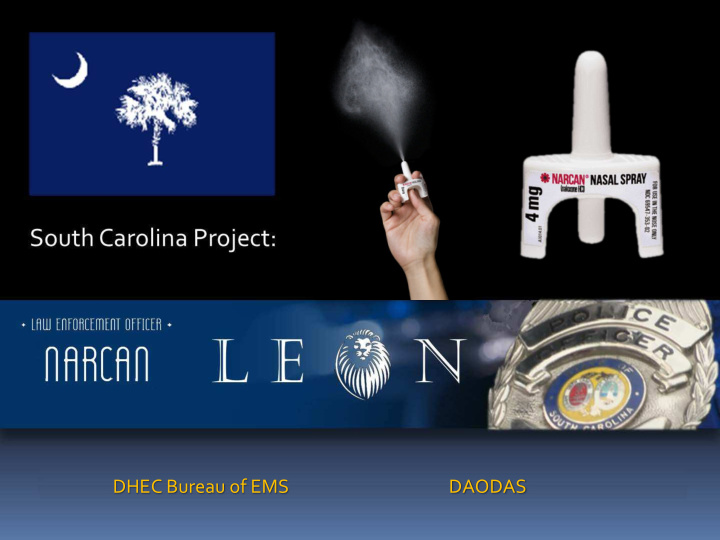



DHEC Bureau of EMS DAODAS
The LEON's goal is to provide a comprehensive training to law enforcement agencies across South Carolina that focuses on The identification The treatment The reporting of drug overdoses attributed to opiates/opioids, such as heroin and narcotic pharmaceutical drugs (Scheduled II).
The program was created pursuant to the 2015 passing of the South Carolina Overdose Prevention Act (S.C. Code Section 44-130-60). The Act seeks to grant immunity from both civil and criminal prosecution, to doctors, pharmacists, caregivers, and first responders , who are engaged in the prescription, dispensation and administration of Naloxone (Narcan) in an opioid- overdose suspected case.
Prescription & Opioid Abuse Drug overdose is currently the leading cause of accidental death in the U.S., with 62,497 * lethal drug overdoses in 2016 or an average of one life every 8½ minutes. In 2016 there were 5.2 million opioid prescriptions dispensed in South Carolina (population 4,961,119). In 2016 there were 366 ** murders in South Carolina but 616 *** opioid deaths. * New York Times , 6/5/2017 ** FBI Annual Crime Report , 10/18/2017 *** DHEC Vital Statistics
2016 Opioid Related Deaths 616 Opioid Deaths 366 Murders
168 311 709 243 132 103 188 132 117 147 509 167 94 109 Per 100,000 people Pickens 200 117 Horry 165 Greenville 144 262 4,610 people Spartanburg 105 Anderson 97 Charleston 67 Richland 36 Yearly Narcan Usage by EMS
South Carolina EMS Narcan Administration – 2016 1,043 111 and Above Per 100,000 people 81 to 110 Horry 342 51 to 80 Pickens 274 Less than 50 Greenville 160 Spartanburg 160 6,427 people Anderson 142 Charleston 119 Richland 62 Yearly Narcan Usage by EMS
S.C. EMS Usage of Narcan in 2017 7,278 administrations To date 12% increase over 2016
WHY LEO: Comparative Response Times For many reasons, EMS is usually not the first emergency responder of the scene of medical emergencies. Average current response time for EMS to all 9-1-1 calls in S.C. is 11:9 minutes (2016 – 675,514 calls) Average response time for FD’s running medical first response 6:41 minutes (2016 – 40,775 calls) Average law enforcement response is usually 3-5 minutes depending on setting (rural / urban / suburban).
Addressing the Problem in South Carolina To date LEON has trained 4,351 officers in 140 agencies in 34 counties with 214 deployments and 191 lives saved. The program offers for free the training, the online reporting portal, access to DHEC pharmacies, statewide standing orders by a physician to carry and administer the Narcan. LEON was awarded a federal SAMHSA grant to continue the program and to purchase Narcan for the program Unless a LEO agency chooses another Narcan product from the one we provide, there is no other cost Your next steps: Memo of Agreement (MOA), scheduling 2 hours for training, and officer list with SC CJA numbers
Addressing Officer Safety LEON program emphasizes Tactics and Safety : there may be situations where it may not be safe to use Narcan. It is 100% up to the individual officer’s discretion. Because of the high potency of the illicit fentanyl and opioid analogues, we recommend officers to carry Narcan to save fellow officers who inadvertently come in contact or inhale the powdered forms. The dosage and route given by LEON is enough to keep an overdosed person breathing and alive . None of the 214 deployments to date have resulted in a problem. Data from other states concur.
Addressing Officer Safety Narcan can also save a canine officer’s life: powdered opioids like fentanyl and carfentanil can be inhaled by them as well as absorbed through the pads on their feet.
Legal Stuff: S.C. 44-130-60 (A) A first responder may administer an opioid antidote in an emergency if the first responder believes in good faith that the person is experiencing an opioid overdose. S.C. Overdose Prevention Act of 2015
Legal Stuff: S.C. 44-130-60 (B)The first responder must comply with all applicable requirements for possession, administration, and disposal of the opioid antidote and administration device. The Department (DHEC) may promulgate regulations to implement this section, including appropriate training for first responders who carry or have access to an opioid antidote. S.C. Overdose Prevention Act of 2015
Legal Stuff: S.C. 44-130-60 (C) A first responder who administers an opioid antidote in accordance with the provisions of this section to a person whom the first responder believes in good faith is experiencing an opioid overdose is not by an act or omission subject to civil or criminal liability or to professional disciplinary action . S.C. Overdose Prevention Act of 2015
Questions? Arnold Alier Kenny Polson Joseph Y. Shenkar EMS Division Director Narcan Coordinator Legal Counsel DHEC Bureau of EMS DHEC Bureau of EMS SC DAODAS aliera@dhec.sc.gov polsonkb@dhec.sc.gov jshenkar@daodas.sc.gov 803-760-5493 803-429-9636 803-315-3357 South Carolina https://www.facebook.com/SCLEONprogram
Recommend
More recommend